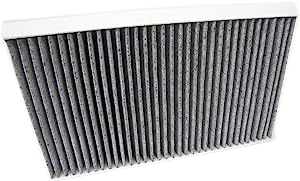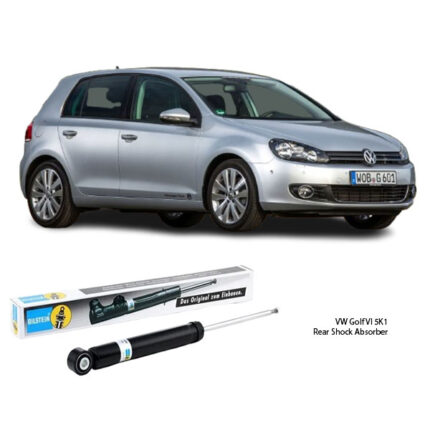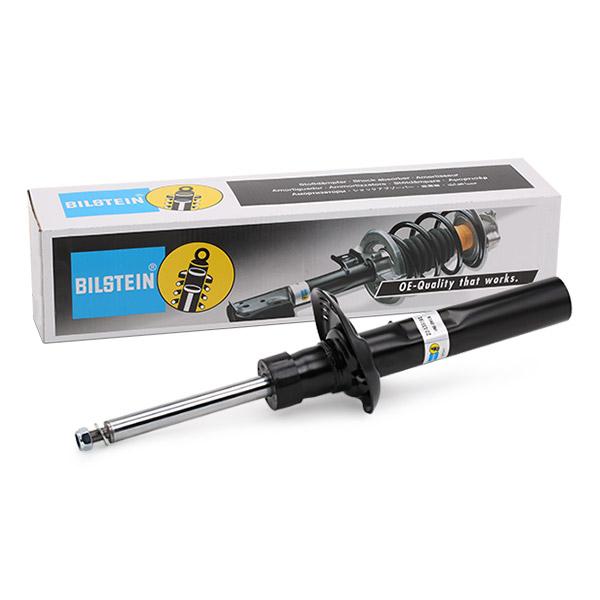-8%
Get Front Shock Absorber Bilstein 1T0413031EK
A shock absorber, also known as a damper, is a mechanical or hydraulic device designed to absorb and dampen shock impulses. It achieves this by converting the kinetic energy of the shock into another form of energy, typically heat, which is then dissipated. The primary function of a shock absorber is to smooth out or dampen the ride by reducing the magnitude of oscillations or vibrations in a vehicle or other systems.
Types:
- Hydraulic (Oil) Shock Absorbers: These use hydraulic fluid to absorb and dissipate energy. When the vehicle’s suspension moves, the fluid is forced through small holes, slowing down the movement.
- Gas-filled Shock Absorbers: These are similar to hydraulic shock absorbers but contain a gas (usually nitrogen) to reduce foaming in the hydraulic fluid, providing a more consistent damping force.
- Coilover Shock Absorbers: These combine a coil spring with a shock absorber, often used in high-performance and off-road vehicles.
- Adjustable Shock Absorbers: These allow the driver to adjust the damping force to suit different driving conditions or preferences.
Operation:
- When the vehicle hits a bump, the suspension compresses and the shock absorber’s piston is forced into the cylinder, displacing hydraulic fluid through the valves.
- As the fluid passes through the valves, it slows down the piston’s movement, thereby absorbing the energy of the impact.
- This process converts kinetic energy into thermal energy, which is dissipated through the fluid and the body of the shock absorber.
Benefits;
1. Improved Ride Comfort
- Damping Oscillations: Shock absorbers reduce the oscillations of the suspension springs, ensuring a smoother ride over uneven surfaces.
- Vibration Reduction: They absorb and dissipate the energy from road irregularities, minimizing vibrations transmitted to the vehicle’s cabin.
2. Enhanced Vehicle Handling
- Stability: By controlling the rebound and compression of the suspension springs, shock absorbers help maintain tire contact with the road, providing better stability.
- Cornering Performance: They reduce body roll during turns, enhancing the vehicle’s cornering ability and overall handling.
3. Increased Safety
- Braking Efficiency: Properly functioning shock absorbers help keep tires in contact with the road during braking, reducing stopping distances.
- Reduced Risk of Hydroplaning: They maintain consistent tire pressure on the road, improving traction and reducing the risk of hydroplaning on wet surfaces.
4. Prolonged Tire Life
- Uniform Tire Wear: Shock absorbers help distribute the vehicle’s weight evenly across all tires, promoting uniform wear and extending tire life.
- Impact Absorption: By absorbing impacts from road irregularities, shock absorbers reduce the stress on tires, preventing premature wear and tear.
5. Protection of Suspension System Components
- Stress Reduction: Shock absorbers lessen the impact forces transmitted to other suspension components, such as springs, control arms, and bushings, thereby extending their lifespan.
- Component Durability: By controlling the motion of the suspension system, shock absorbers prevent excessive wear and damage to suspension parts.
6. Driver and Passenger Comfort
- Reduced Fatigue: A smoother ride reduces driver and passenger fatigue, especially on long journeys, contributing to overall well-being.
- Noise Reduction: By dampening vibrations, shock absorbers also reduce noise levels within the vehicle’s cabin.
7. Enhanced Off-Road Capability
- Terrain Adaptability: In off-road conditions, shock absorbers help maintain vehicle control and comfort over rough and uneven terrains.
- Load Management: They assist in managing the vehicle’s load more effectively, ensuring stability and control even under heavy load conditions.
8. Consistent Performance Over Time
- Temperature Management: High-quality shock absorbers can manage temperature variations, maintaining consistent performance in different weather conditions.
- Durability: Modern shock absorbers are designed to last longer, providing reliable performance over an extended period.
Signs of a worn out shock absorber;
- Excessive Bouncing:
- If your vehicle continues to bounce after going over a bump, it indicates that the shock absorbers are not dampening the motion effectively.
- Nose Dives and Rear Squats:
- When braking, the front end of the vehicle dives down more than usual, or when accelerating, the rear end squats excessively, it can indicate worn shock absorbers.
- Poor Handling and Instability:
- The vehicle may feel unstable, especially when making turns or changing lanes. This instability can make the vehicle difficult to control.
- Uneven Tire Wear:
- Worn shocks can cause uneven tire wear, such as cupping or scalloping on the tires, due to the tires losing contact with the road.
- Leaking Fluid:
- If you notice oil or hydraulic fluid leaking from the shock absorbers, it is a clear sign that they are worn out and need replacement.
- Increased Stopping Distance:
- Worn shock absorbers can increase your vehicle’s stopping distance because they are not able to keep the tires firmly planted on the road.
- Unusual Noises:
- Knocking or rattling noises when going over bumps or rough roads can indicate that the shock absorbers or their mounts are worn.
- Vibrations:
- Excessive vibrations in the steering wheel or throughout the vehicle can be a sign of worn shock absorbers.
- Swerving or Veering:
- If your car swerves or veers to one side when driving straight, especially on rough roads, it can indicate that the shocks are not keeping the vehicle stable.
- Visible Damage:
- Inspecting the shock absorbers for visible damage, such as dents, rust, or other physical deformities, can also indicate they are worn out.
Follow us on Facebook for more parts.



